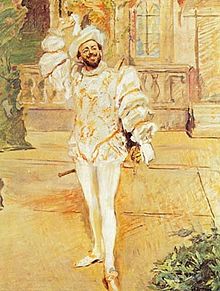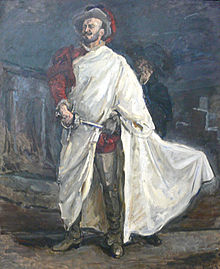The champagne song

The Champagne Song or The White d'Andrade is an oil painting by Max Slevogt . It is 215 cm x 160 cm, 1901 / 1902 emerged and now hangs in the Staatsgalerie Stuttgart .
The White d'Andrade is one of three large-format paintings that Slevogt dedicated to the Portuguese baritone Francisco d'Andrade . It is considered an important work of German late impressionism , which, with its painterly, impasto style of painting, cemented Slevogt's artistic reputation alongside Lovis Corinth and Max Liebermann .


At the same time, Slevogt introduced the new picture type of the role portrait in Germany. Lovis Corinth painted further role portraits with Gertrud Eysoldt as Salome in 1903 and Rudolf Rittner as Florian Geyer in 1906. "When the actors completely dissolve in their roles, they can be identified with the fate of those who embody them," writes Armin Second . There are numerous preliminary studies and variants of the painting. Further small replicas can be found in the Dr. Gaubitz, Hamburg and owned by his son d'Andrades in Lisbon. However, The Champagne Song could be influenced by Édouard Manet's portrait of Jean-Baptiste Faure as Hamlet . Whether Slevogt knew this painting, which has been in the Folkwang Museum in Essen since 1927, has not been established with certainty.
The motif shows the namesake of Mozart's opera Don Giovanni during the aria Finch'han dal vino, calda la testa (The champagne song ). Don Giovanni, the great seducer of women, stands in the center of a bright picture space against a backdrop-like background. As a princely host, he gave the order with great grandeur to prepare a big party so that it would be easier for the women to achieve his goal. "On then to the feast, it should be happy, until my guests glow with wine" (1st act, 15th scene).
The opera singer Francesco d'Andrade (* 1858 in Lisbon; † 1921 in Berlin), who celebrated great success in Berlin at the turn of the century, was considered a model interpreter of Don Giovanni . Slevogt met d'Andrade, who was praised as "demonic instinct" for the performance of this role, for the first time in 1894 in a performance of Don Giovanni conducted by Hermann Levi at the Royal Court Opera in Munich and became friends with him. “Until his death Slevogt could not get rid of the creative imagination of the Don Giovanni motif. The d'Andrade pictures were repeated in etchings, woodcuts and lithographs ”. When the singer Francesco d'Andrade died in 1921, Slevogt painted Don Giovanni's Entombment .
Another painting by Slevogt on this subject is The Black d'Andrade (oil on canvas, 150 cm × 109 cm) from 1903 , which is based on the penultimate scene of the piece (2nd act, 14th scene). It shows Don Giovanni, dressed in black and yellow, how his right hand is gripped by the commander's white marble hand. The Hamburger Kunsthalle acquired the work in 1969 from Francisco d'Andrade jr.
Slevogt's Roter d'Andrade (The singer Francisco d'Andrade as Don Giovanni) , oil on canvas, 210 cm × 170 cm, received far more attention . When in 1912, on the recommendation of Ludwig Justi, a first painting by Slevogt was to be acquired for the Nationalgalerie Berlin , Kaiser Wilhelm II became the Der Weisse d'Andrade and the painting Roter d'Andrade (with the churchyard scene, Leporello in the background) from the same year ) presented for selection in black and white images. Slevogt painted the picture in anticipation of a purchase from the National Gallery. Wilhelm II: decided in favor of this newer, “ secessionist ” image, a selection that was criticized and later described as a mistake.
Slevogt designed the sets for performances of Don Giovanni in Berlin and Dresden.
literature
- Bruno Bushart : The singer D'Andrade as Don Giovanni . Introduction. Stuttgart: Reclam 1959. (Reclams Universal Library. 9047.)
Individual evidence
- ↑ Armin Second ao: Lovis Corinth: paintings and prints , Städtische Galerie im Lenbachhaus Munich, Prestel, 1975, p. 53, ISBN 978-3-7913-0368-0
- ^ Catalog of the Staatsgalerie, Staatsgalerie Stuttgart, Stuttgarter Galerieverein, 1962
- ^ Art Chronicle, Central Institute for Art History in Munich, Association of German Art Historians, p. 61, H. Carl, 1969
- ↑ Ernst Kraus: Opera from A-Z . Breitkopf and Härtel, Leipzig, 1969, p. 473
- ^ Neue Zeitschrift für Musik , B. Schott, 1969, p. 460, v.130 1969
- ↑ Karl-Josef Kutsch , Leo Riemens : Large singer lexicon . Saur, 1991, p. 1186, ISBN 3-907820-69-X
- ↑ Michael Dorrmann: Eduard Arnhold (1849-1925): A biographical study of business and patronage of the German Empire . Akademie Verlag, 2002, p. 160, ISBN 978-3-05-003748-6
- ↑ Ernst Kraus: Opera from A-Z . Breitkopf and Härtel, Leipzig, 1969
Web links
- Max Slevogt: The champagne song in the Staatsgalerie Stuttgart
- Petra Kipphoff: The eye sees what it is looking for. In: Die Zeit of August 7, 1992, No. 33
